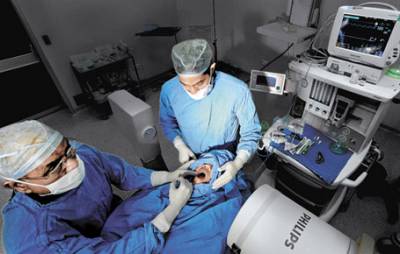New services to reduce your agony are cropping up. And they are a big business opportunity as well.
Jaideep Sajdeh,owner of Mumbai-based textile recycling firm Texool, and an active club-level cricketer, sustained a nasty knee injury while playing two and a half years ago. As a result, he had torn a ligament and cartilage, and the ensuing pain was unbearable. Doctors advised surgery, but the 42-year-old was not ready for it and thought of trying alternative medicine. That too did not work. After 4-5 months, a physiotherapist suggested a visit to Pain Clinic of India, run by Dr Kailash Kothari, an anaesthesiologist and
pain management specialist.
“The doctor gave me three injections at an interval of 1-2 weeks. With the first injection itself, the nagging pain was gone,” says Sajdeh. The entire treatment spread over 3-4 months cost Rs 15,000, while surgery would have cost Rs 1.5 lakh. “If I go for the same treatment in the US, it would have cost around $800,” says Sajdeh, who is now getting a nagging pain in the heel treated, and also plans to take a few booster injections to strengthen his knees.
Gone are the days of living with excruciating and recurring pain. A new breed of super-specialist pain healers is the go-to solution. The speciality is being added to leading public and corporate hospitals. Moreover, standalone pain clinics and even chains are coming up.“Pain medicine is the youngest of all specialties. It used to be a sub-branch of anaesthesia,” says Dr Assad Hussain, who specialises in anaesthesiology at the sports medicine centre of Fortis Healthcare-controlled Quality Healthcare Medical Services (QHMS) in Hong Kong. Says Dr Anupam Sibal, group medical director of Apollo Group of Hospitals: “With the loss of manpower, stress, psychological trauma and various other socio-economic issues a patient has to undergo, pain should be considered a disease.” Modern healthcare providers recognise that chronic pain patients need multi-disciplinary care. The pain management department is no longer an extension of the departments of physiotherapy or palliative care(comprehensive treatments to improve the quality of life of patients and their families who are facing problems associated with life-threatening illness).

Specialist Solution
Experts say that in India, chronic pain affects 30 per cent of the adult population, particularly women and the elderly. About 20-25 per cent of them suffer from musculoskeletal disorders or MSD (which affect muscles, joints, tendons, ligaments and nerves) and joint disorders. Back pain accounts for another 25-30 per cent. Headache and migraine is the reason behind 5 per cent of cases of persistent pain, while another 2 per cent suffer from pain related to cancer.
“Of the 100-120 patients who visit each of my centres every month, the majority comes for treatment of backache and slipped discs, followed by neuropathic (nerve-related diseases or damage) issues and accident victims,” says Kothari, whose chain has six clinics in Mumbai, and one each in Goa and Mauritius.
Says Dr K.J. Choudhary, chairman of Samvedana Hospital and Pain Management Institute in New Delhi and senior anaesthesia consultant with the Apollo Group: “Of the 10-15 chronic patients I see every day, only 2-3 require surgery to control the pain.”
Apart from pain specialisation at leading hospitals, an estimated 30-40 standalone pain clinics have come up in India in recent years, including Pain Clinic of India, Delhi Pain Management Centre (promoted by G.P. Dureja, who set up a pain management clinic at the All India Institute of Medical Sciences, AIIMS, way back in 1986), Samvedana Hospital in Noida, Dardia Pain Clinic in Kolkata, among others. Mumbai alone is estimated to have 15 such clinics. And then there are the centres in tier-2 cities such as Dr Hitesh Patel’s Livewell, Giriraj Pain Management Centre and Pain Care Clinic in Ahmedabad. Experts say that most cities have at least 2-3 pain clinics.
ADVANTAGE:
Fortis Healthcare is implementing an interventional pain management programme in many of its hospitals (Biwash Banerjee)
TENDER CARE
Pain clinics specialize in more than a dozen methods of treatment:
- Epidural (spinal) injections: given under real-time X-rays using a fluoroscope
- Radio frequency ablation: a high-frequency alternating current is used to treat a medical disorder
- Microscopic discectomy: a surgery to cure pain due to slipped discs
- Ozone therapy: more oxygen is introduced in the body by injecting ozone; used in back pain management
- Sympathetic blocks: involves injecting numbing medicine around the nerves in the lower back or neck to get rid of pain temporarily
- Blocks for cervical pain: an injection to relieve neck, shoulder or arm pain
- Cancer pain management
- Diabetic neuropathic pain management: treating pain or loss of feeling in the toes, feet, legs, hands, and arms due to diabetes
- Advanced neuromodulation therapy: advanced medical device technologies to enhance or suppress activity of the nervous system for the treatment of a disease
- Ultrasound-guided nerve blocks
- Spinal cord stimulator: a device used to exert pulsed electrical signals to the spinal cord to control chronic pain.
A reason for the profusion could be the relatively low cost of setting up a pain clinic. “The investment in a pain clinic is about Rs 50 lakh (for a rented building in a tier-2 city) and breakeven can happen within a year,” says Kothari. Compared to this, a modern eye care clinic may require 2-3 times the investment, and a longer gestation period; a corporate hospital with 250 beds breaks even in 5-7 years.
“The infrastructure required is also not much for a pain clinic — one or two consultation rooms and small operation theatres, physiotherapy equipment, etc. Pain clinics do not need an in-patient ward as most of the treatments do not need hospitalisation. “We have tie-ups with hospitals for surgeries that require hospitalisation,” says Kothari.
Pain management is an upcoming speciality and it is yet to develop as an organised specialty,” says Amit Mookim, partner, global strategy group and industry head of healthcare at KPMG. He notes that the most profitable segment is the specialised injections used in such clinics. Although no industry figures are available, the size of the pain management market is at least Rs 200 crore for just the standalone centres, and this does not include the cost of related pain medication.







